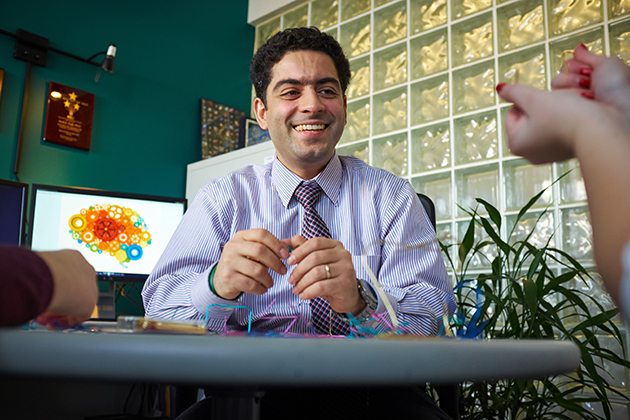People with attention deficit hyperactivity disorder (ADHD), some studies suggest, are more creative and more willing to take risks. Those traits are exactly what the field of engineering needs, say a team of researchers, but the traditional model of teaching is driving away potential pioneers in the field.
With funding from the Research in Engineering Education, a program of the National Science Foundation (NSF), they’re embarking on a study designed to find a better way to teach these students.
People with ADHD often have poor time management skills and, depending on the tasks, have trouble focusing and can be prone to procrastination. But ADHD is also strongly associated with the ability to think quickly in unconventional ways – the kind of thinking that can find solutions to the types of complex problems that engineers often encounter.
Yet traditional engineering training rarely takes advantage of these strengths, say the researchers, who come from the fields of engineering, education, psychology, and psychopharmacology. It tends to be rigid, and sets very narrow goals for students, says Arash E. Zaghi, assistant professor of civil and environmental engineering. Students with attention deficit hyperactivity disorder (ADHD) – while no less intelligent than their peers – are stymied by the traditional model of engineering education.
“It doesn’t leave enough room for creativity,” says Zaghi, a principal investigator on the study. “We’re so comfortable with our instruction now that we haven’t recognized that we aren’t sufficiently fostering creativity.”
Zaghi was diagnosed with ADHD when he was 32. Although drawn to engineering, Zaghi felt frustrated by the traditional methods of teaching engineering, with its inflexible and unprovocative curriculum and overwhelming problem-solving assignments. As a teacher, he has encouraged students to experiment.
“I always leave room for crazy ideas,”says Zaghi, who has been with the School of Engineering since 2011.
The first-stage research project has received a competitive RIGEE (Research Initiation Grants in Engineering Education) grant for about $150,000 for two years from the National Science Foundation. The study will compare the difference in creative thinking between engineering students with ADHD and other engineering students, and identify what factors might be hindering the success of those with the condition. For the study, researchers will administer the Torrance Test of Creativity, the most widely used metric for creative thinking.
Besides Zaghi, the research team consists of education theoreticians, educational psychologists, gifted education specialists, academic advisors, and a consultant in psychopharmacology. Among them is Sara Renzulli, a learning specialist for UConn’s Counseling Program for Intercollegiate Athletes who was also diagnosed with ADHD. She says students with ADHD who ultimately succeed scholastically often do so by finding their own ways of capitalizing on their unconventional thinking.
Giving scope to creativity

According to recent studies, between 4 percent and 7 percent of the population has ADD or ADHD. Rising awareness of the condition has increased diagnoses. Approximately one-third of adolescents diagnosed with ADHD do not receive their high school diploma; the drop-out rate for the general population is about 5 percent.
And of those with ADHD who do go to college, the demographic is severely underrepresented in the field of engineering. One study found that only 3 percent of college students with ADHD were enrolled in engineering programs, compared to 76 percent who were enrolled in colleges of arts and sciences.
At the high school level, Renzulli says, academic advisors may be unaware of the nature of traditional engineering training, and unwittingly send creative students with ADHD into programs that are a poor fit.
“[Students with ADHD] are looking for things that are hands on, so an advisor will say ‘You should go into engineering,’” she says.
With the funding, the research team expects to recruit approximately 15 engineering students with ADHD characteristics. They will also use surveys to evaluate how the grades of the students with ADHD correlate with the classes they enjoyed the most.
The research team also includes Distinguished Professors Sally Reis and Joseph Renzulli, both internationally renowned scientists in the area of educational psychology. Joseph Renzulli is recognized for his work in the field of gifted education, and Reis is known for her research on intellectually gifted children who also have some form of learning difference. Joyce Kamanitz, a psychopharmacologist, will assist the research team in determining whether ADHD medicines – which help the academic performance of these students – affect their creative thinking.
Stephanie D’Souza, another PI on the study, is a researcher with the A.J. Pappanikou Center for Excellence in Developmental Disabilities, who has focused on academically gifted university students with learning differences. She says the study is the first step in getting educators to see that students with ADHD are just as capable of learning as others, but require different methods.
“One of the goals of this project is to help dispel some of the myths about individuals with ADHD,” she says, “and help not only professors but also the students themselves see that ADHD does not mean stupid or lazy, it is simply a different learning need.”
In a separate initiative, Professor Mark Tehranipoor, director of UConn’s nationally-known cybersecurity lab CHASE, is recruiting students with ADHD because he feels their creativity and ability to think outside the box is critical to his kind of research and beating computer hackers at their own game. He just received a Research Experience for Undergraduates (REU) grant from NSF to pursue the approach.



